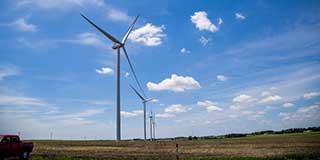 Spring 2019
Spring 2019
Got Solar and Wind? You Bet.
 This year marks a new wind farm for MGE—Saratoga is the company’s largest wind farm yet. It comes online 20 years after one of MGE’s first wind projects, the Rosiere Wind Farm in Kewaunee County, Wisconsin.
This year marks a new wind farm for MGE—Saratoga is the company’s largest wind farm yet. It comes online 20 years after one of MGE’s first wind projects, the Rosiere Wind Farm in Kewaunee County, Wisconsin.
“We were out ahead of everyone else in Wisconsin when we built our first wind farm,” says Steve Pitts, MGE’s manager of construction engineering. “There weren’t a lot of suppliers or contractors who knew how to build one back then. Even the landowners didn’t know what to expect. We were all taking a risk.”
In 1999, MGE’s 11-megawatt (MW) Rosiere Wind Farm was the largest wind farm east of the Mississippi River. Today, Pitts is again overseeing another “first” for wind farms in the United States.
“The types of turbine and blades at Saratoga have never before been used at a wind farm in this country,” says Pitts. “The blades are longer than others out there. Because of that, serrated edges were added to them to increase efficiency and to reduce noise.”
Saratoga’s 33 Vestas turbines stretch across about 8,300 acres of farmland in northeast Iowa. At 66 MW, Saratoga will deliver enough clean energy to power about 47,000 households. The new wind farm came online in February.
“The turbines at Saratoga will run autonomously. They sense when the wind is strong enough to generate electricity,” Pitts says. “The pitch of the blades adjusts automatically when wind speeds change to ensure they rotate within operating limits. If the wind changes direction, the turbines turn the direction of the blades as well for optimal production.”
Two wind farms, two decades apart
“The turbines have become much bigger and more efficient,” explains Pitts. “Twenty years ago, when we built our Rosiere Wind Farm, we couldn’t have conceived of what we now see at Saratoga.” Saratoga’s turbines reach more than 200 feet higher than Rosiere’s turbines. Their height allows them to take advantage of greater wind speeds aloft. As a result, each turbine will generate about three times the amount of electricity as turbines at Rosiere. MGE’s Saratoga wind farm is another step in the company’s ongoing transition toward greater use of renewable resources. Clean energy is one of its strategies toward deep decarbonization.
MGE is targeting at least a 40% reduction in carbon emissions by 2030 and at least an 80% reduction by 2050. The company has committed to going further faster, if it can, by working together with its customers.
New solar projects
In May, MGE announced plans to partner with another Wisconsin utility on two solar projects. If approved, the projects will add 100 MW of new solar to MGE’s energy supply mix, providing cost-effective, clean energy for MGE customers.
The solar project known as Badger Hollow Farm would be in Iowa County, about 12 miles west of Dodgeville, Wisconsin. MGE’s ownership share would be 50 MW. The Two Creeks Solar project would be located near the City of Two Rivers, Wisconsin. MGE’s ownership share would be 50 MW. If approved, both projects could come online by the end of 2020.
MGE also is planning to expand its popular community solar program, Shared Solar, with a second solar installation. The voluntary program offers locally generated solar energy. Customers who subscribe to Shared Solar may receive up to half of their annual electric use through the program.
MGE’s Shared Solar program launched in early 2017. The City of Middleton and MGE partnered to place a 500-kilowatt array on the roof of the City’s Municipal Operations Center. The program sold out quickly. An expansion of the program will allow more customers to participate and advance shared energy goals for our community. To join the waiting list to participate, visit mge.com/SharedSolar.
In addition to our renewable energy investments, MGE is working toward deep decarbonization by advancing electric vehicles and using new technologies to increase engagement around energy efficiency, both of which are recognized as key strategies for reducing carbon dioxide emissions.
Back to Cover